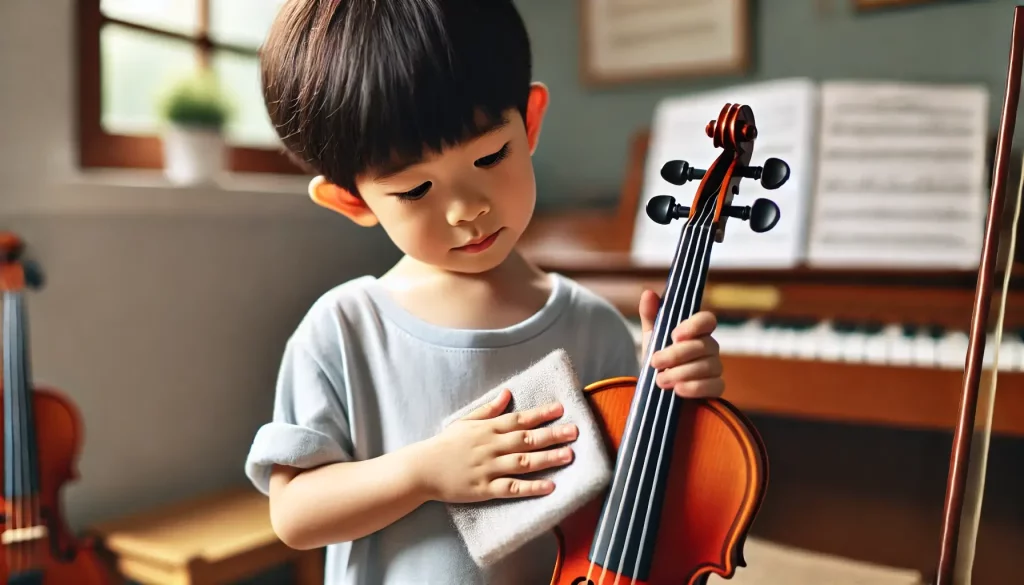There’s something special about watching a child learn an instrument. It’s more than just music—it’s discipline, patience, and responsibility wrapped into one. But while kids are quick to pick up a melody, they don’t always understand the importance of taking care of their instrument. A violin isn’t just another toy—it’s a delicate piece of craftsmanship that requires attention and care. Teaching a child how to protect their violin isn’t just about preventing damage; it’s about instilling a sense of respect, responsibility, and pride in their craft. Here’s how to make sure that valuable instrument stays in top shape while also teaching valuable life lessons along the way.
Establishing a Routine of Care
Kids thrive on routine, and taking care of a violin should be no different than brushing teeth or making the bed. From the moment they first pick up the instrument, they should understand that proper care is part of being a musician. That means always putting the violin back in its case when it’s not being used, wiping down the strings and body after practice, and making sure the bow is loosened before storing it.
Small habits like these prevent unnecessary damage and reinforce responsibility. The key is consistency—when care becomes second nature, the violin lasts longer, and the child learns the value of looking after their belongings. One way to ensure this is by incorporating violin care into a exercise routine. Just like warming up their fingers before playing, they can build a habit of checking their instrument and case before and after practice. Simple actions like stretching their arms while wiping down the violin or practicing careful bow handling as a dexterity drill can make maintenance feel like a natural part of their musical development.
Teaching Proper Handling and Storage
A violin is fragile, and even a small drop or a little too much pressure on the bridge can cause costly damage.
Kids need to be taught the right way to handle their instrument from the start—always holding it by the neck, never gripping it too tightly, and being mindful of where they place it down. When not in use, the violin should always be kept in its case, preferably in a safe, temperature-controlled space.
Leaving it out on a bed or leaning against a chair is an accident waiting to happen. By setting clear rules and explaining why they matter, parents can help their child develop careful, respectful habits that will keep their violin in great shape for years to come.
Invest In A Great Case
A quality case is an investment that protects not just the instrument but also the time, effort, and money put into a child’s musical journey. A well-padded, durable case shields the violin from temperature changes, accidental drops, and everyday wear and tear.
Parents should consider investing in a sturdy, well-fitted case with secure latches and a humidity control system to keep the violin in optimal condition. Teaching a child to respect and properly handle their case reinforces responsibility and ensures their instrument remains safe for years to come.
Cleaning and Maintenance Made Simple
A well-maintained violin not only lasts longer but also sounds better. Teaching a child simple cleaning habits will keep their instrument in top condition. After each practice, a soft cloth should be used to wipe away rosin dust from the strings and body—this prevents buildup that can dull the sound and damage the varnish. The bow should never be touched directly on the horsehair, as oils from fingers can affect the grip on the strings.
Parents can also help by scheduling occasional checkups with a luthier to ensure the bridge, pegs, and strings are all in good shape. By making maintenance a regular part of their musical journey, a child learns that caring for their tools is just as important as playing them.
Setting Expectations with Clear Consequences
Kids don’t always understand the value of their belongings unless it’s put into perspective. A violin isn’t just another object—it’s an investment in their growth and talent. Setting clear expectations about how it should be treated is essential. If a child forgets to store it properly or leaves it somewhere unsafe, there should be gentle but firm consequences, such as pausing practice until they can show responsibility.
On the flip side, reinforcing good habits with praise or small rewards can help instill a sense of pride in taking care of their instrument. Teaching respect for the violin isn’t about being overly strict—it’s about helping them develop an appreciation for the things that enable their passions.
Instilling Lifelong Responsibility
Teaching a child to care for their violin goes beyond simply protecting an instrument—it instills a sense of discipline, respect, and responsibility that will serve them well in all aspects of life. By establishing a routine, emphasizing proper handling, maintaining the violin and its case, and setting clear expectations, parents can help their young musician develop good habits that last a lifetime. A well-cared-for violin not only sounds better but also allows a child to take pride in their craft. With the right guidance, they’ll learn that music isn’t just about playing notes—it’s about cherishing the tools that make it possible.
Cassia Rowley is the mastermind behind advertising at The Bad Pod. She blends creativity with strategy to make sure ads on our site do more than just show up—they spark interest and make connections. Cassia turns simple ad placements into engaging experiences that mesh seamlessly with our content, truly capturing the attention of our audience.


